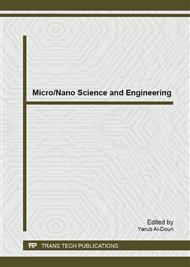[1]
F. Boico, B. Lehman, Multiple-input Maximum Power Point Tracking algorithm for solar panels with reduced sensing circuitry for portable applications, J. Solar Energy 86 (2012) 463–475.
DOI: 10.1016/j.solener.2011.10.017
Google Scholar
[2]
P. Görbe , A. Magyar, K. M. Hangos, Reduction of power losses with smart grids fueled with renewable sources and applying EV batteries, J. Cleaner Production 34 (2012) 125-137.
DOI: 10.1016/j.jclepro.2011.12.021
Google Scholar
[3]
P. Bajpai, V. Dash, Hybrid renewable energy systems for power generation in stand-alone applications: A review, J. Renewable and Sustainable Energy Reviews 16 (2012) 2926– 2939.
DOI: 10.1016/j.rser.2012.02.009
Google Scholar
[4]
B. ChittiBabu, et. al, Synchronous Buck Converter based PV Energy System for Portable Applications, Proceeding of the 2011 IEEE Students' Technology Symposium 14-16 Jan. (2011), 335 - 340.
DOI: 10.1109/techsym.2011.5783839
Google Scholar
[5]
A. Robion, et. al, Breakthrough in Energy Generation for Mobile or Portable Devices, 978-1-4244-1628-8/07/$25. 00 ©2007 IEEE, (2007), 460 - 466.
Google Scholar
[6]
M. H. Imtiaz, et. al, Design & Implementation Of An Intelligent Solar Hybrid Inverter In Grid Oriented System For Utilizing PV Energy, International Journal Of Engineering Science And Technology, Vol. 2(12), 2010, 7524-7530.
Google Scholar
[7]
M. S. Varadarajan, Coin Based Universal Mobile Battery Charger, IOSR Journal of Engineering (IOSRJEN) ISSN: 2250-3021 Vol. 2, Issue 6 (June 2012), 1433-1438.
DOI: 10.9790/3021-026114331438
Google Scholar
[8]
R. M. Akhimullah, Battery Charger with Alarm Application, Thesis of Bachelor Of Electrical Engineering (Power System), University Malaysia Pahang, November, 2008, pp: 1-24.
Google Scholar
[9]
M. A. Baharin, Solar Bicycle, thesis MSc. Bachelor Of Electrical Engineering (Power Systems), University Malaysia Pahang, November, 2010, pp: 1-24.
Google Scholar
[10]
J. Tyner, et. al, The Design of a Portable and Deployable Solar Energy System for Deployed Military Applications, Proceedings of the 2011 IEEE Systems and Information Engineering Design Symposium, University of Virginia, Charlottesville, VA, USA, April 29, (2011).
DOI: 10.1109/sieds.2011.5876854
Google Scholar
[11]
C. Li, et. al, Solar Cell Phone Charger Performance in Indoor Environment, 978-1-61284-8928-0/11/$26. 00 ©2011 IEEE, (2011), pp: 1-2.
Google Scholar
[12]
Q. I. Ali, Design & Implementation of a Mobile Phone Charging System Based on Solar Energy Harvesting, Iraq J. Electrical and Electronic Engineering, Vol. 7 No. 1, ( 2011), 69 - 72.
DOI: 10.33762/eeej.2011.42004
Google Scholar
[13]
K. Ishaque, Z. Salam, A review of maximum power point tracking techniques of PV system for uniform insolation and partial shading condition, J. Renewable and Sustainable Energy Reviews, 19, (2013), 475–488.
DOI: 10.1016/j.rser.2012.11.032
Google Scholar
[14]
A. Higier, Design, development and deployment of a hybrid renewable energy powered mobile medical clinic with automated modular control system, J. Renewable Energy , 50, (2013), 847 - 857.
DOI: 10.1016/j.renene.2012.07.036
Google Scholar
[15]
M.H. Taghvaee, et. al, A current and future study on non-isolated DC–DC converters for photo voltaic applications, J. Renewable and Sustainable Energy Reviews, 17, (2013) 216–227.
DOI: 10.1016/j.rser.2012.09.023
Google Scholar
[16]
R. Komiyama, Analysis of Possible Introduction of PV Systems Considering Output Power Fluctuations and Battery Technology, Employing an Optimal Power Generation Mix Model, Electrical Engineering in Japan, Vol. 182, No. 2, (2013), p.1705–1714.
DOI: 10.1002/eej.22329
Google Scholar


